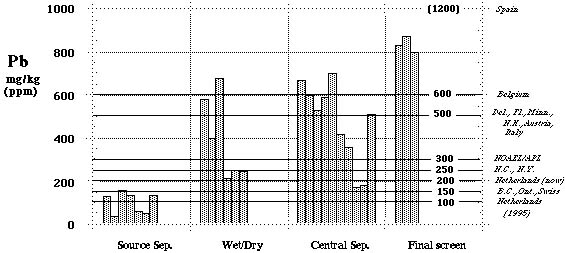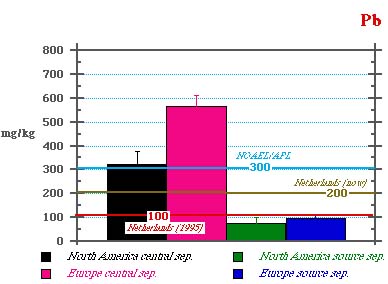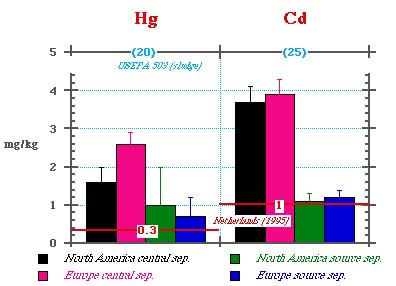

During the last few years, composting has gained wide acceptance as a key component of integrated solid waste management. However, a vigorous debate continues about what materials should be composted, and, in particular, whether composting should be limited to organic wastes separated at their source (e.g., by individual households) or applied more broadly to mixed municipal solid waste (MSW). There are several important trade-offs between these approaches, including the quantity of material diverted from landfills, the quality of the final compost,the impact on recycling, and the cost.
Understandably, many potential compost users are concerned about physical and chemical contaminants in composts made from mixed refuse. New screening and separation technologies can help minimize the problem of physical contaminants (bits of glass, plastic, and metal) in MSW composts. Chemical contaminants, which include both toxic organic chemicals (e.g., PCB's and dioxins) and heavy metals (e.g., lead and mercury), pose a greater problem.
Organic chemicals may expose compost workers to potential risks during waste processing. Some may also be of concern in finished composts. However, there is not enough data on these compounds to adequately assess how different separation approaches affect organic contaminant levels. Thus, this fact sheet will focus primarily on heavy metal contaminants.
Those metals of greatest concern in compostcadmium, mercury, and leadcan be harmful to animals and humans at relatively low concentrations and tend to accumulate in soil, plants, and animals. For most of these potentially harmful metals, the levels in MSW composts are low relative to levels considered acceptable in sewage sludges (a.k.a. biosolids), i.e., the No Observed Adverse Effect Level (NOAEL) or Alternate Pollutant Limit (APL) allowed for unrestricted distribution by the US EPA (Fact Sheet 6). While MSW composts can usually meet these proposed sludge regulatory limits for most metalswith the significant exception of lead there is an increasing interest in achieving even lower levels. Many regulators and policy makers, concerned that the risk assessment methodologies used to develop standards such as NOAEL may be based on insufficient data, are taking a more conservative approach (Fact Sheets 5 and 6).
Several European countries and Canadian provinces have proposed or enacted extremely strict stan dards, which are sometimes based on background levels of these elements in the soil (Fact Sheet 6). The range of regulatory standards for lead are illustrated in Figure 1. Compost users may demand even higher standards of quality than the regulators. Effective separation of contaminants is therefore likely to be increasingly important for successful marketing of MSW compost products.
Sources of Contamination
Batteries, consumer electronics, ceramics, light bulbs, house dust and paint chips, lead foils such as wine bottle closures, used motor oils, plastics, and some glass and inks can all introduce metal contaminants into the solid waste stream.
Batteries are a particularly significant source of metal contaminants. Even after 80% of lead-acid automobile batteries are recovered for recycling, the remaining 20% are estimated to contribute 66% of the lead in MSW in the U.S. Household batteries account for approximately 90% of the mercury, though that level is projected to decline greatly as manufacturers remove mercury from alkaline batteries. Nickel-cadmium batteries may be responsible for up to 52% of the cadmium.
Another study has estimated that 27% of the lead and 9% of the cadmium are contributed by consumer electronic goods, including TVs, calculators, and stereos. Plastics are estimated to contribute approximately 30% of the cadmium as well as significant amounts of nickel and lead. Metals in plastics and some other fractions of the MSW stream can be difficult to recover because they are so widely dispersed.
Options for Reducing Contaminant Levels
While there are a wide variety of possible approaches to reducing contaminant levels in MSW compost, most can be placed in one of five categories (See Table 1). This list can be viewed as a kind of hierarchy, with options at the top of the list having greater potential to minimize contaminants than those lower down. All options except for the first can be implemented at the local level.
Table 1. Options For Reducing Contaminant Levels in MSW Composts
Option 1:
Reduce or Eliminate Contaminant Levels in Products Destined to Become MSW
Changes in product design could greatly broaden waste management options, decreasing the potential for toxicity associated with all disposal methods and separation strategies. For example, a combination of regulatory and voluntary reductions in the use of heavy metal based inks during the last decade has dramatically reduced metal levels in paper products, and thus made waste paper much more attractive for recycling, livestock bedding, composting and incineration. If no products containing high concentrations of lead were ever manufactured, there would be little concern with lead in MSW compost. Because this option is beyond control of the local governments usually responsible for solid waste management, it is too often neglected. Nonetheless, it has significant potential to reduce contamination.
Option 2:
Separate Clean Organic Materials at the Source
This option generally requires households to separate their waste into three streams: 1) recyclable, 2) compostable (yard trimmings, food scraps, and non-recyclable paper), and 3) materials destined for disposal.
A variety of organic waste source separation programs (sometimes referred to as "biowaste" or "green waste composting") have been developed in recent years. This approach has largely been initiated in Europe where concerns about metal contamination have yielded increasingly strict regulations that sometimes effectively prohibit mixed waste collection.
In North America, yard waste composting has already been adopted in many communities. Some facilities have added other segregated streams, including cafeteria, restaurant, supermarket, produce market, food processing, and paper/cardboard residues. A few are following the lead of communities in Europe, collecting a fuller range of source-separated organic materials from both residential and commercial generators.
Wet/Dry Collection
A few communities have implemented an intermediate strategy, commonly referred to as wet/dry collection. This approach segregates the waste stream into only two components: a wet fraction containing food, yard, non-recyclable packaging and paper waste, and possibly diapers, pet waste, and sweepings; and a dry fraction containing materials destined for recycling. Items destined for disposal may be directed to either stream depending on whether recyclables or compostables are emphasized. To serve as an effective source-separation program for MSW composting, contaminants must be directed to the dry fraction.
Option 3:
Separate Contaminants at the Source
Unlike Option 2 which separates compostable materials from other waste, this approach attempts to remove those items identified as problems from the waste stream. Thus, while Option 2 is sometimes referred to as a "positive" sort for compostables (desirable materials are the target), Option 3 can be considered a "negative" sort (undesirable materials are the focus). Household hazardous waste (HHW) programs are an example of this approach. Problems with this method are that not all targeted contaminants will be separated, some contaminated wastes cannot be manually separated (e.g., house dust and paint chips) and those not separated from other waste will remain in the stream destined for composting.
Option 4:
Separate Contaminants at a Centralized Facility Prior to Composting
As levels of inorganic materials in the waste stream have increased, a wide range of technologies have been developed to separate contaminants prior to composting. Most modern MSW composting facilities include some of these "front-end" technologies, including manual picking lines, size separation, magnetic or eddy-current metal recovery, air classification, and other mechanical approaches (see Fact Sheet 1). These separation processes can be applied at several points in a single facility: e.g., front-end separation may be followed by additional separations after an initial decomposition period and again at the end of the process. However, such approaches rarely target the specific sources of contaminants, many of which are not particularly amenable to these centralized separation approaches. Lead is a particularly difficult contaminant, since current mechanical technologies are not effective at separating lead acid batteries and consumer electronics, the major sources of lead in MSW.
Option 5:
Separate Contaminants at a Centralized Facility After Composting
The first generation of MSW composting facilities depended on screening after composting as the primary means of contaminant separation. However, as noted below, delaying separation until after composting normally results in the highest levels of metal contamination. Thus, while this approach may be used as an additional step in the separation process, it is rarely used alone any more.
Relative Effectiveness of the Various Strategies on Compost Quality
Where minimizing metal contaminants is the goal, evidence from both experimental separation trials and operating facilities present a strong case for source (e.g. household) separation of waste. In fact, the earlier that sorting occurs during the collection and composting process, the lower the metal contamination in the finished compost (Figure 1). Similarly, in the case of sludge, industrial pretreatment is the most effective means of contaminant reduction.
Figure 1. Lead (Pb) levels in MSW composts from experimental studies comparing several separation approaches. Regulatory standards from several U.S. states, Canadian provinces, and European countries are listed on the right axis.

Once contaminants are mixed with compostables, they become increasingly difficult to recover. Leaching, abrasion, and mixing disperse contaminants in a mixed waste stream, and separation becomes less effective with time or intensive processing. Some contaminants, such as motor oil and oil in filters, are liquid and, therefore, subject to spill. Abrasion during waste handling can break off bits of lead from foil or weights. Fine dust or paint chips can attach to otherwise clean organic wastes. Even seemingly sturdy materials, such as consumer electronics, can contaminate neighboring organic materials through leaching and direct contact prior to, and during, collection.
Several studies indicate that household separation of organic materials from other waste (Option 2) yields higher quality compost than attempts to separate contaminants (Option 3). One reason is that contaminants remain in the waste stream destined for composting if separation doesn't occur. In addition, the current approach to HHW collection emphasizes solvents and other organic chemicals. Recovery rates are low, costs are very high, and the metal contaminants of concern in MSW composts (e.g., wine bottle caps, solder, shot pellets, and fishing weights) are rarely targeted.
Researchers in Germany and the Netherlands have compared both source separation of organic materials and wet/dry collection (Option 2) with centralized separation prior to composting (Option 4) and final screening only (Option 5). Source separation composts have the lowest contaminant levels, while wet/dry systems vary depending on emphasis (Figure 1). Centralized separation produced composts of variable quality, while the most contaminated composts were those where final screening was the primary separation approach. Data for lead are provided in Figure 1, along with regulatory limits in several states in the U.S., Canadian provinces and European countries. Data for other metal contaminants followed similar trends.
A Cornell study analyzed published heavy metal data from over 100 operating MSW composting facilities in Europe and North America. Source separation of organic materials produced significantly lower contaminant levels than centralized separation (Figures 2 and 3). The data indicate that many centralized separation facilities do not meet proposed U.S. standards for lead, and also suggest that even source separation may not consistently achieve the strict standards being implemented in the Netherlands, without additional contaminant reductions.
Figure 2. Average lead (Pb) levels in MSW composts from facilities using centralized separation to remove contaminants versus source separation of organic compostables in North America and Europe. Proposed USEPA (NOAEL/APL) standards as well as regulatory limits from the Netherlands are included for comparative purposes.

Figure 3. Average mercury (Hg) and cadmium (Cd) levels in MSW composts from facilities using centralized separation to remove contaminants versus source separation of organic compostables in North America and Europe. Proposed USEPA (NOAEL/APL) standards as well as regulatory limits from the Nethlands are included for comparative purposes.

Considering Quantity and Cost
Quality of the finished compost, however, is only one of several important criteria in the MSW composting debate. Policy makers and facility operators must also consider relative program costs and human behavior (e.g. how willing are individuals to separate their garbage).
For composting, as with recycling, conventional wisdom holds that mixed waste results in much higher diversion rates than are possible with source separated organic collection. However, this assumption has yet to be put to a comprehensive test. In fact, some initial evidence exists that suggests the reverse. Estimates of total diversion potential from source-separated organic collection, for example, are usually in the range of 25-50%. Fillmore County, Minnesota- the first full-scale U.S. facility that is processing residential source-separated organic materials- has exceeded these projections. They estimate that the total diversion to composting is approximately 50%, with an additional 15-20% recovered for recycling.
In a pilot-scale comparison of wet/dry source separation with complete source separation, the city of Guelph, Ontario recovered 96% of all organic and recyclable waste with the two-stream wet/dry collection, and 85% with a three-stream source separation program.
While such examples are by no means conclusive, they indicate that mixed waste collection may not always maximize recovery of compostable and recyclable material. The actual results in any community will depend, in part, on the extent and effectiveness of education programs and the motivation of community members.
Program costs are a critical factor in selecting separation and processing options. Unfortunately little information is available about the economics of these choices. Differences among communities in variables such as housing density and waste generation volumes and types will affect the trade-offs between source-separated collection and centralized processing costs.
Optimizing Centralized Separation Technology
Although current data show that source-separated waste will yield higher quality compost, it is possible that centralized separation may be capable of achieving lower contaminant levels than current results indicate. At present, most of the separation technology has been designed and optimized for materials recovery and recycling rather than contaminant removal. Reducing overall MSW contaminant levels (Option 1) and separating any remaining concentrated contaminants such as lead-acid batteries and TV tubes at the source (Option 3) would further reduce contaminant levels in centralized separation systems.
Better use of existing technologies (e.g., new combinations of screening and air classification) could help reduce the lead content associated with heavy fine particles. Knowledge of specific contaminant sources, combined with an analysis of the separation efficiency of various technologies, could also help centralized separation achieve its full potential for contaminant reduction.
Priorities for Additional Research
Ultimately, pilot studies of "real world" collection programs are needed to compare actual program costs and quantities of compostables recovered from source-separated and centralized approaches. Additional research to identify specific sources of key contaminants such as lead, explore the potential for intensive contaminant source separation, and optimize centralized separation technologies for key contaminants is also critical to the success of MSW composting.
References
See the fully referenced article in a special issue of Biomass & Bioenergy (Vol. 3, Nos 3-4, pp. 195-211, 1992), from which this fact sheet is extracted. A copy of that journal containing 11 articles on MSW composting can be obtained through the Composting Council, 114 S. Pitt St., Alexandria, VA 22314.
Published by Cornell Waste Management Institute, Dept of Crop and Soil Sciences, Ithaca, NY 14853. 607-255-1187..
The research for this paper was supported in part by funds provided by Clark Engineers and Associates and the State of New York through the NYS Energy Office. Their support of this work is gratefully acknowledged. Thanks to Stephen Ebbs who carried out the massive literature search necessary to the preparation of this fact sheet. The authors are solely responsible for the papers' contents, although they gratefully acknowledge helpful comments and discussion with numerous colleagues.
Special thanks to Margo Hittleman who assisted in developing this fact sheet from the longer technical paper.
For specific comments related to this page, please contact
the Cornell Waste Management
Institute (format and style), or Tom
Richard (technical content).
This page was created on January 16, 1996
This page was last updated March 2005
Cornell
Waste Management Institute ©1996
Dept of Crop and Soil Sciences
101 Rice Hall, Cornell University
Ithaca, NY 14853-5601
607-255-1187
cwmi@cornell.edu